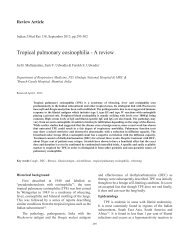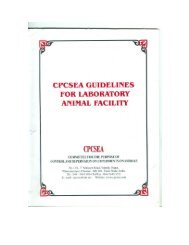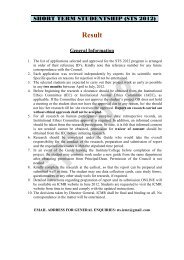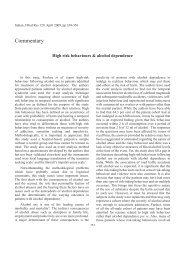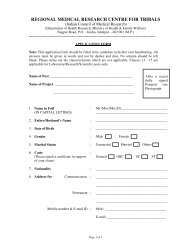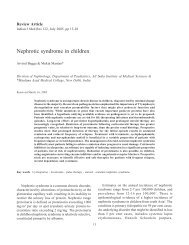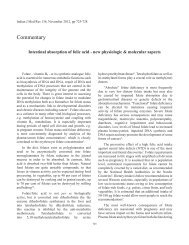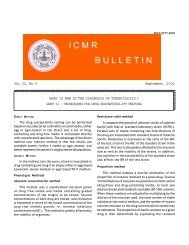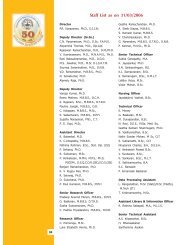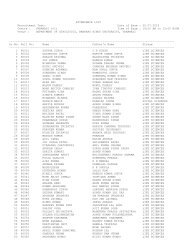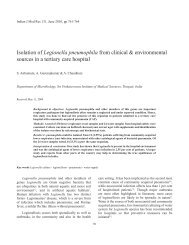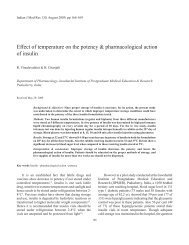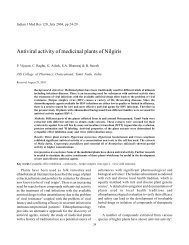Azadirachta indica - Indian Council of Medical Research
Azadirachta indica - Indian Council of Medical Research
Azadirachta indica - Indian Council of Medical Research
Create successful ePaper yourself
Turn your PDF publications into a flip-book with our unique Google optimized e-Paper software.
HABLUETzEL et al: A. iNdiCA AS A PUBLIC HEALTH TOOL FOR MALARIA & OTHER VECTOR-BORNE DISEASES 113<br />
been successfully reduced by the wide use <strong>of</strong> insecticide<br />
treated bed nets (ITN) and indoor residual spraying<br />
(IRS) 17 . Targeting adults has the advantage that, under<br />
sufficient coverage conditions, an impact not only on<br />
mosquito densities but also on mosquito longevity<br />
is achieved, resulting in a reduction in the number<br />
<strong>of</strong> infective mosquitoes. The recent encouraging<br />
results have raised renewed confidence that malaria<br />
elimination or at least a major reduction <strong>of</strong> transmission<br />
is feasible, even in African settings. To reach this goal,<br />
however, integrated vector control needs to be adopted<br />
as a strategy, supplementing ITN and IRS with larval<br />
control measures tailored to the eco-epidemiological<br />
settings. Larviciding is suitable for urban and peri-urban<br />
areas, where permanent and semi-permanent breeding<br />
sites are identifiable, and has a potential also in settings<br />
characterized by a markedly seasonal vector activity,<br />
where it allows the transmission season to be shortened<br />
by treating breeding sites15 . Biological larvicides, such<br />
as neem based products, have a valuable role to play in<br />
such integrated vector control endeavours.<br />
The insecticides <strong>of</strong> choice for treating bednets<br />
and mosquito netting are synthetic pyrethroids such<br />
as permethrin, deltamethrin and alpha-cypermethrin.<br />
However, the emergence <strong>of</strong> pyrethroid-resistant vector<br />
species in many endemic areas and the threat <strong>of</strong> losing<br />
these effective insecticides for malaria control, urge<br />
for the development <strong>of</strong> alternatives. May <strong>Azadirachta</strong><br />
<strong>indica</strong> be a potential resource for the development <strong>of</strong><br />
new insecticides for the treatment <strong>of</strong> netting or housing?<br />
Neem based insecticides act on target organisms mainly<br />
after oral uptake. However, contact activity has been<br />
described in some species. For example, the topical<br />
application <strong>of</strong> neem oil or azadirachtin rich neem<br />
seed kernel extract on Glossina specimens, reduced<br />
fecundity and survival <strong>of</strong> the treated females18 and<br />
exposure <strong>of</strong> An. stephensi and An. culicifacies females<br />
to volatile neem compounds was found to impair<br />
vitellogenesis19 . On the basis <strong>of</strong> these evidences, studies<br />
aimed at elucidating absorption mechanisms <strong>of</strong> neem<br />
molecules trough the cuticle <strong>of</strong> adult mosquitoes and at<br />
identifying bioactive compounds acting on mosquito<br />
tissues should be encouraged and may help to pave the<br />
way to the development <strong>of</strong> neem based adulticides.<br />
The use <strong>of</strong> neem to combat mosquito nuisance<br />
makes part <strong>of</strong> the traditional knowledge ‘backpack’<br />
<strong>of</strong> many Asian and African populations. Studies are<br />
now available that confirm the repellent efficacy <strong>of</strong><br />
neem oil when applied on exposed skin parts20 and<br />
that support the use <strong>of</strong> neem oil in kerosene lamps<br />
to expel blood seeking mosquitoes from houses 21 . A<br />
recent entomological study conducted in experimental<br />
houses in an area <strong>of</strong> Tanzania shows that the traditional<br />
custom <strong>of</strong> burning <strong>Azadirachta</strong> leaves and other plant<br />
species (e.g., Ocimum sps.) reduces human biting and<br />
indoor resting <strong>of</strong> mosquitoes 22 . Such validation studies<br />
on traditional vector and disease control measures<br />
should be encouraged to provide a rational basis for<br />
integrated disease control, ‘integrated’ not only in<br />
terms <strong>of</strong> combining different measures but also in terms<br />
<strong>of</strong> exploiting both, modern science and traditional<br />
medicine knowledge.<br />
A. Habluetzel * , L. Lucantoni & F. Esposito<br />
Department <strong>of</strong> Experimental Medicine & Public Health<br />
University <strong>of</strong> Camerino<br />
62032 Camerino (MC), Italy<br />
* For correspondence:<br />
annette.habluetzel@unicam.it<br />
References<br />
1. Neem Foundation. Abstract book - World Neem Conference;<br />
November 21-24, 2007; Coimbatore, India. Mumbai: Neem<br />
Foundation; 2007.<br />
2. National <strong>Research</strong> <strong>Council</strong> (US). Board on Science and<br />
Technology for International Development. Neem: a tree for<br />
solving global problems. Washington, DC: National Academy<br />
Press; 1992.<br />
3. Biswas K, Chattopadhyay I, Banerjee RK, Bandyopadhyay<br />
U. Biological activities and medicinal properties <strong>of</strong> neem<br />
(<strong>Azadirachta</strong> <strong>indica</strong>). Curr Sci 2002; 82 : 1336-45.<br />
4. Parida MM, Upadhyay C, Pandya G, Jana AM. Inhibitory<br />
potential <strong>of</strong> neem (<strong>Azadirachta</strong> <strong>indica</strong> Juss) leaves on dengue<br />
virus type-2 replication. J Ethnopharmacol 2002; 79 : 273-8.<br />
5. Udeinya IJ, Mbah AU, Chijioke CP, Shu EN. An antimalarial<br />
extract from neem leaves is antiretroviral. Trans R Soc Trop<br />
Med Hyg 2004; 98 : 435-7.<br />
6. Yanes A, Finol HJ, Hasegawa M. Effects <strong>of</strong> <strong>Azadirachta</strong><br />
<strong>indica</strong> and Melia azedarach (Meliaceae) extracts from leaves<br />
on Trypanosoma cruzi growth and ultrastructure. J Submicrosc<br />
Cytol Pathol 2004; 36 : 149-54.<br />
7. El Tahir A, Ibrahim AM, Satti GMH, Theander TG, Kharazmi<br />
A, Khalid AS. The potential antileishmanial activity <strong>of</strong> some<br />
Sudanese medicinal plants. Phytother Res 1998; 12 : 576-9.<br />
8. Udeinya JI, Shu EN, Quakyi I, Ajayi FO. An antimalarial<br />
neem leaf extract has both schizonticidal and gametocytocidal<br />
activities. Am J Ther 2008; 15 : 108-10.<br />
9. Mishra V, Parveen N, Singhal KC, Khan NU. Antifilarial<br />
activity <strong>of</strong> <strong>Azadirachta</strong> <strong>indica</strong> on cattle filarial parasite Setaria<br />
cervi. Fitoterapia 2005; 76 : 54-61.<br />
10. Mulla MS, Su T. Activity and biological effects <strong>of</strong> neem<br />
products against arthropods <strong>of</strong> medical and veterinary<br />
11.<br />
importance. J Am Mosq Control Assoc 1999; 15 : 133-52.<br />
Habluetzel A, Carnevali F, Lucantoni L, Grana L, Attili AR,<br />
Archilei F, et al. Impact <strong>of</strong> the botanical insecticide Neem



